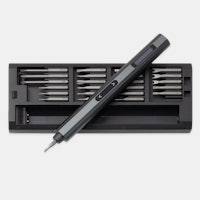Click to view our Accessibility Statement or contact us with accessibility-related questions




Deconstructing Dominaria Limited

search
close
Sort by: Newest
keyboard_arrow_down
Let’s get the conversation started!
Be the first to comment.
PRODUCTS YOU MAY LIKE
Trending Posts in More Community Picks

Graham88
Completely surprised by the lack of blade diversity here on Drop...
I’ve been a collector of Blades since before my teens, and a retailer coming up on 15… or maybe 20 years. Drop has really been kind of an interesting experience for me, because I do occasionally get to see some unusual tech and sometimes EDC items that otherwise I might not have been aware of. And maybe it’s because I have a deep love of cutlery and bladed weapons, but I find myself trolling through the site looking at it what’s available; and it’s just it’s pretty much the same. And the bladed community here is just always confused me.. every single knife is about the same, they’re almost all drop points and although the handle materials change and brands change.. it’s really just the same knife over and over and over again... occasionally you’ll see a tanto or a slight variant; but rarely… and almost never a serrated blade. And I’m just deeply amazed at this diversion of serrated blades. And I’m just surprised there isn’t more of a request for diversity here.... and I...
Mar 12, 2020
JellyDPhoto
Can we get Sony E-Mount or other mirrorless camera options please..
Would be nice to see some Sony E mount full frame cameras on here. I currently shoot with a A99 and they killed the lense path for better or more option lenses and now is all E-Mount. 🤔
Jan 13, 2020
RayF
There Are Pandas, and Then There Are Pandas.
And this isn't either of them! The Pandas we're talking about here, are watches, not bears. And what got me thinking about them (again) was a link posted this morning by @cm.rook who pointed a few of us to the very attractive (and not terribly priced) Yema "Rallygraph" Panda which, in it's most traditional arrangement, looks like the one on the left, but can also be had in the version on the right: The model on the left is a true Panda, while the model on the right is called a reverse Panda. The reason for that distinction is clear--Panda bears, only come in the first arrangement. Now at this point, everyone should be thinking about the most well-know Panda, The Rolex Panda, which is actually a Daytona, and among Rolex Daytonas, the most famous of which is the Paul Newman Daytona, which was famous first, because it was Paul's, and second because it sold at auction for $17.8 million (US Dollars). The story of that auction is well-known so I'll only...
Nov 8, 2019






My goal for today is to share some of the advance preparation I do whenever a new set comes out to try break things down and ramp up the learning curve. While it's difficult to get a full handle on everything right off the bat, the work I do now will help me establish a context to learn from. In anticipation of the Prerelease and GP Columbus, my initial focus will be on Sealed deck. I'll be taking a look at how creatures will interact, how good the removal is, what combat tricks to be aware of, and what the strongest colors are.
Creatures - Power & Toughness Breakdown The sizing of common creatures form the cornerstone or any Limited format. Each color usually has only one or two at each casting cost, and these define a baseline of what to expect as the game unfolds. A lot of good defensive creatures with high toughness will cause games to draw out, whereas aggressive creatures will encourage trading and make combat tricks more valuable. While most sets will have a mix, there are usually trends that determine whether something like a 2/3 for three mana is a card you actively want or chaff that you would almost never play. Let's take a look at each color.
White
1cc Tragic Poet 1/1 2cc Benalish Honor Guard 2/2, Knight of New Benalia 3/1, Mesa Unicorn 2/2, Serra Disciple 1/1 fly 3cc D'Avenant Trapper 3/2, Pegasus Courser 1/3 fly, Sergeant-at-Arms 2/3 4cc Aven Sentry 3/2 fly, Call the Cavalry 2x 2/2 5cc Excavation Elephant 3/5
From an objective standpoint, the white creatures are slightly anemic. They are skewed a bit towards the defensive side, and rely on evasion as none of the ground creatures can get through an x/4 blocker without assistance. White decks will likely look to gum up the ground with tokens and defensive creatures while attacking in the air. The versatility offered by Sergeant-at-Arms would make it my early pick as the best of the bunch.
Blue
1cc Artificer's Assistant 1/1 fly 2cc Vodalian Arcanist 1/3, Relic Runner 2/1 3cc Academy Drake 2/2 fly, Tolarian Scholar 2/3 4cc Homarid Explorer 3/3 5cc Academy Journeymage 3/2, Cloudreader Sphinx 3/4 fly 6cc Cold-Water Snapper 4/5
Although there are synergy considerations that might improve things, the blue creature suite looks pretty terrible. Like the white creatures, they are pretty much hamstrung by an x/4 blocker, but, unlike white, don't have very good defensive options either. Cloudreader Sphinx does standout of the crowd, and will likely be one of the best blue commons.
Black
1cc Stronghold Confessor 1/1 (3/3 kicked) 2cc Cabal Evangel 2/2, Caligo Skin-Witch 1/3, Rat Colony 2/1 3cc Deathbloom Thallid 3/2, Drudge Sentinel 2/1 4cc Cabal Paladin 4/2, Thallid Omnivore 3/3 5cc Windgrace Acolyte 3/2 fly 6cc Feral Abomination 5/5
The black commons have a more aggressive slant with Cabal Paladin being the first mid-sized creature able to trade with a 2/4. Creatures still seem a little on the weak side, however, but that's more or less normal for black which usually boasts some of the best removal. Deathbloom Thallid looks like an important role-player for token decks, and the threat of activation makes Thallid Omnivore difficult to block.
Red
1cc Ghitu Lavarunner 1/2, Skirk Prospector 1/1 2cc Bloodstone Goblin 2/2, Ghitu Chronicler 1/3, Keldon Warcaller 2/2 3cc Ghitu Journeymage 3/2, Keldon Overseer 3/1 4cc Keldon Raider 4/3, Rampaging Cyclops 4/4 5cc Fire Elemental 5/4
Red finally presents a group of creatures designed to attack. Several feature higher power than toughness, and mid-sized four drops like Keldon Raider won't just trade with an opposing Grizzly Bear. As you go up the curve, the creatures scale appropriate to get past enemy blockers with even Fire Elemental matching up favorably against defensive five drops like Excavation Elephant.
Green
1cc Llanowar Elves 1/1 2cc Corrosive Ooze 2/2, Llanowar Scout 1/3, Saproling Migration 2x 1/1 3cc Krosan Druid 2/3, Llanowar Envoy 3/2, Yavimaya Sapherd 2/2 + 1/1 4cc Baloth Gorger 4/4, Gaea's Protector 4/2 5cc Mammoth Spider 3/5 6cc Primordial Wurm 7/6
With less removal options than other colors, green traditionally relies on the quality of its creatures. That seems to be the case here as there are good options on both attack and defense, along with the notable return of cheap mana acceleration in the form of Llanowar Elf. Whether deployed on turn four or seven, Baloth Gorger will often be the biggest creature on the battlefield, and cards like Yavimaya Sapherd and Mammoth Spider put a stop to opposing aggression. The only concern is a lack of evasion which will force green decks to find other ways to break through.
Artifacts
1cc Sparring Construct 1/1 2cc Voltaic Servant 1/3 3cc Aesthir Glider 2/1 fly, Skittering Surveyor 1/2 4cc 5cc Guardians of Koilos 4/4 6cc Pardic Wanderer 5/5
None of the common artifact creatures are particularly exciting, but they do provide a bit of toolbox for colors lacking in particular qualities. Aesthir Glider is a serviceable flyer for example, and Guardians of Koilos will block three power creatures in a pinch.
Looking at the common creatures overall, I would say that four toughness is an important threshold, especially for defensive creatures. There are plenty of decent three drops like Ghitu Journeymage or Deathbloom Thallid that will trade with anything smaller, and if all you're doing is trading, most two drops will prove adequate. For that reason, I'm much less in spending an extra mana for a 2/3 like Tolarian Scholar.
Removal The next piece of information to examine is the removal suite each color has access to. This will help determine how good creature auras are, and whether bombs are likely to go unanswered. Since common removal is often fairly restrictive, I like to consider uncommons as well. Especially in Sealed, people will try to play as much removal as they can even if they have to splash for it, which means you'll see the good uncommons a little more frequently.
Red seems to have access to the most quality creature removal, even if some cards like Radiating Lightning are pretty restrictive in terms of what they can kill. Black is probably next with Eviscerate and Vicious Offering at common, and white holds its own with three pieces of removal that can all be cast at instant speed. By contrast, blue and green are much more limited and will likely be forced to rely on combat tricks and tempo, though it's worth noting that In Bolas's Clutches is more than just a removal spell, and will contend for top billing as one of the best uncommons. Bloodtallow Candle can be played in any deck, and will kill most creatures if you're willing to invest enough mana.
Combat Tricks The effectiveness of combat tricks varies from format to format, but it's always useful to know what your opponent is capable of at any given time. Spells that cost one or two mana are especially noteworthy, as you can make deductions based on what color of mana is left up turn after turn. Although you won't always be able to blank these completely, you'll often want to minimize their impact by avoiding risky double blocks.
Each color seems to have a very limited number of instant speed options. You can't always play around everything, but knowing what your opponent might have at their disposal will help you evaluate risk and make informed decisions.
Other Noteworthy Effects In addition to combat tricks and removal, I like to note a few other kinds of cards that usually appear in small numbers and are occasionally worth playing around.
Flash Creatures - Don't Get Ambushed!
Haste Creatures - Watch Out for the Counterattack!
Sudden Evasion & Falter Effects - Watch Out for Lethal!
Counterspells - Time Your Key Spells!
Sacrifice Effects & Discard - Protect Your Bombs!
While the combat tricks are worth memorizing, this section is mostly about noticing trends. Red has a bunch of haste creatures, for example, so be careful with your attacks if you're at a low life total. Similarly, black has access to Caligo Skin-Witch, so it's probably worth keeping a couple lands in hand if you don't need the mana.
Evaluating the Colors Now that we've broken down some of the format's characteristics, I'm interested in looking at each color again to identify which ones appear strongest and are likely to be played more frequently. To help structure the discussion, I'll be assigning ratings to characteristics like aggression and removal quality. In each case, the scale will be from 1 to 5, with 5 being the highest.
White
Aggression: 2 Creature Quality: 3 Removal Quality: 3 Overall Strength for Sealed: 3
Blue
Aggression: 2 Creature Quality: 1 Removal Quality: 2 Overall Strength for Sealed: 2
Black
Aggression: 3 Creature Quality: 3 Removal Quality: 4 Overall Strength for Sealed: 3
Red
Aggression: 4 Creature Quality: 4 Removal Quality: 5 Overall Strength for Sealed: 5
Green
Aggression: 3 Creature Quality: 5 Removal Quality: 1 Overall Strength for Sealed: 4
I think red's the best color coming out of the gate on account of a reasonable creature suite backed by quality removal. Green would be my next choice, despite the lack of removal, simply because it has the best creatures. Many of these creatures scale as good late-game options thanks to the kicker mechanic. White and black are serviceable while, in most cases, I'd be looking at blue as mainly a support color. Not everyone will play red/green as players will want to cast whatever broken rares they open, but if I had to guess, I'd say that Mountains and Forests are the most likely to be in short supply at your local Prerelease, so build your decks with that in mind.
Bonus Section - Lands & Play/Draw I will likely adjust this opinion after playing the format, but my initial feeling is that most decks would prefer to be on the draw. Most of the creatures are sized to trade off in combat, which means games are likely to develop into an attrition war or board stall. If that's the case, attacking first doesn't matter as much as it usually does, and the extra card will help you find your bombs and removal. These qualities also make splashing more attractive.
On the surface, an attrition-based format encourages a lower land count to avoid flooding out, but that's somewhat mitigated by the kicker mechanic which allows you to spend mana to generate additional value. Going into the Prerelease, my default would be to play 17 lands, though I may adjust up or down depending on the number of mana sinks I have.
That pretty much completes my initial analysis of the format. Of course, I'll continue to refine my evaluations once the set actually comes out. Whether you're trying to win some packs at your Prerelease or are interested in more serious events, I hope this gives you a good head start in trying to understand Dominaria Limited.
In case you haven't already seen them, here are some links to other articles from my Massdrop teammates:
· Meet the Massdrop Teams: http://dro.ps/mtg-team-announce · *2nd* at Pro Tour Ixalan: http://dro.ps/ixalan · Unclaimed Creature Types: http://dro.ps/ari-creatures · Why I Never Drop From Tournaments: http://dro.ps/eric-nevergiveup · The Art of Sideboard Construction - Sultai Energy: http://dro.ps/jon-sideboard · A Commoner’s View on Pauper: http://dro.ps/mark-pauper · Blue Moon Beach Control: http://dro.ps/scott-bluemoon · Top 5 Modern Decks: http://dro.ps/pascal-modern · Storm in Vintage Cube: http://dro.ps/ben-storm · An Early Look at Rivals for Standard: http://dro.ps/shaun-rivals · A Standard Approach to Evaluating New Cards: http://dro.ps/rob-newcards · Drafting Rivals of Ixalan: http://dro.ps/tim-ixalan · Team Sealed Secrets: http://dro.ps/eric-secrets · Steal My Standard Ideas: http://dro.ps/tommy-secrets · Vexing Devil. Any Questions?: http://dro.ps/jon-devil · Team Massdrop Rivals of Ixalan Limited Primer: http://dro.ps/ari-primer · Gestation of RG Eldrazi: http://dro.ps/ben-gestation · Top Time Tournament Training Tips: http://dro.ps/tim-tips · What Makes Someone Bogle?: http://dro.ps/tommy-bogle · A Pauper Adventure: http://dro.ps/pascal-pauper · Blue Moon at GP Phoenix: http://dro.ps/rob-bluemoon · Brawling into Dominaria: http://dro.ps/scott-brawling · The Saga Genesis https://dro.ps/shaun-genesis
Join the Dominaria Booster Box Preorder here: https://www.massdrop.com/buy/dominaria-booster-box